Abstract
Cultured porcine aortic endothelial cells were conditioned through two passages to mimic euglycemic and hyperglycemic conditions (5.2 mM, normal glucose; 15.6 mM, elevated glucose). After incubation with 1 microM [14C]arachidonic acid for 24 h, the cells were stimulated with 1 microM A23187 for times up to 30 min. Uptake of [14C]arachidonic acid and its distribution among cell lipids were unaffected by the increased glucose concentration. The release of eicosanoids from labeled cells and unlabeled cells was measured by reverse-phase HPLC and by RIA, respectively. Compared with cells stimulated in the presence of normal glucose concentrations, cells stimulated in the presence of elevated glucose released 62.6% less free [14C]arachidonic acid, but released 129% more 14C-labeled 15-hydroxyeicosatetraenoic acid (HETE). Increased release of 15-HETE in the presence of elevated glucose in response to A23187, bradykinin, and thrombin was confirmed by RIA. A similar increase in 5-HETE release was observed by RIA after A23187 treatment. The release of both radiolabeled and unlabeled prostanoids was equal at both glucose concentrations. The data indicate that glucose may play an important role in the regulation of release and metabolism of arachidonic acid after agonist stimulation. In the presence of elevated glucose concentrations, such as those associated with diabetes mellitus, the extent and pattern of eicosanoid release from endothelial cells is markedly altered.
Full text
PDF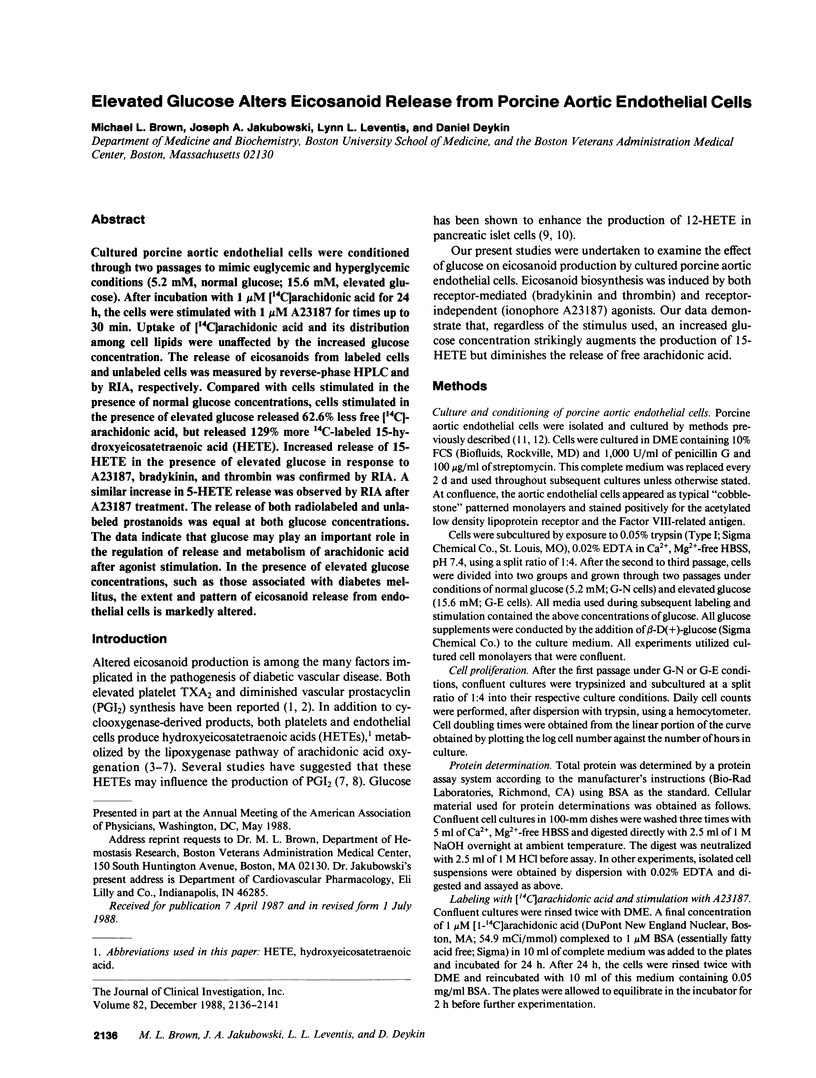
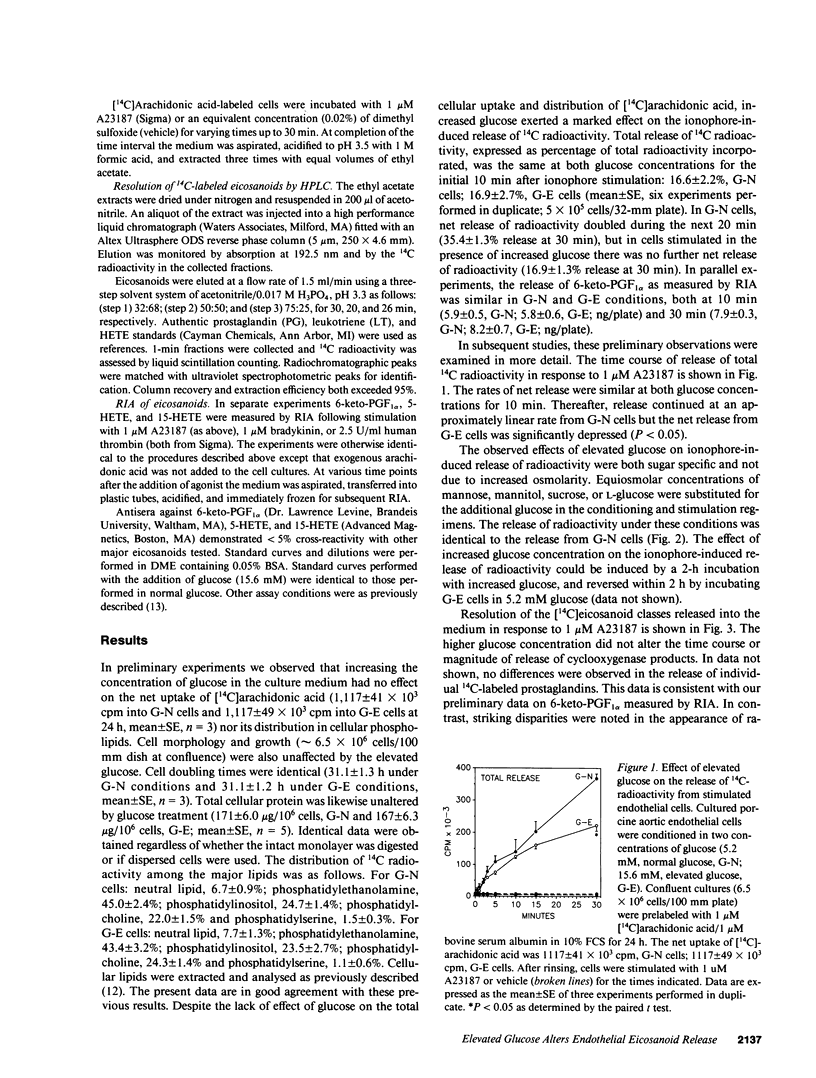
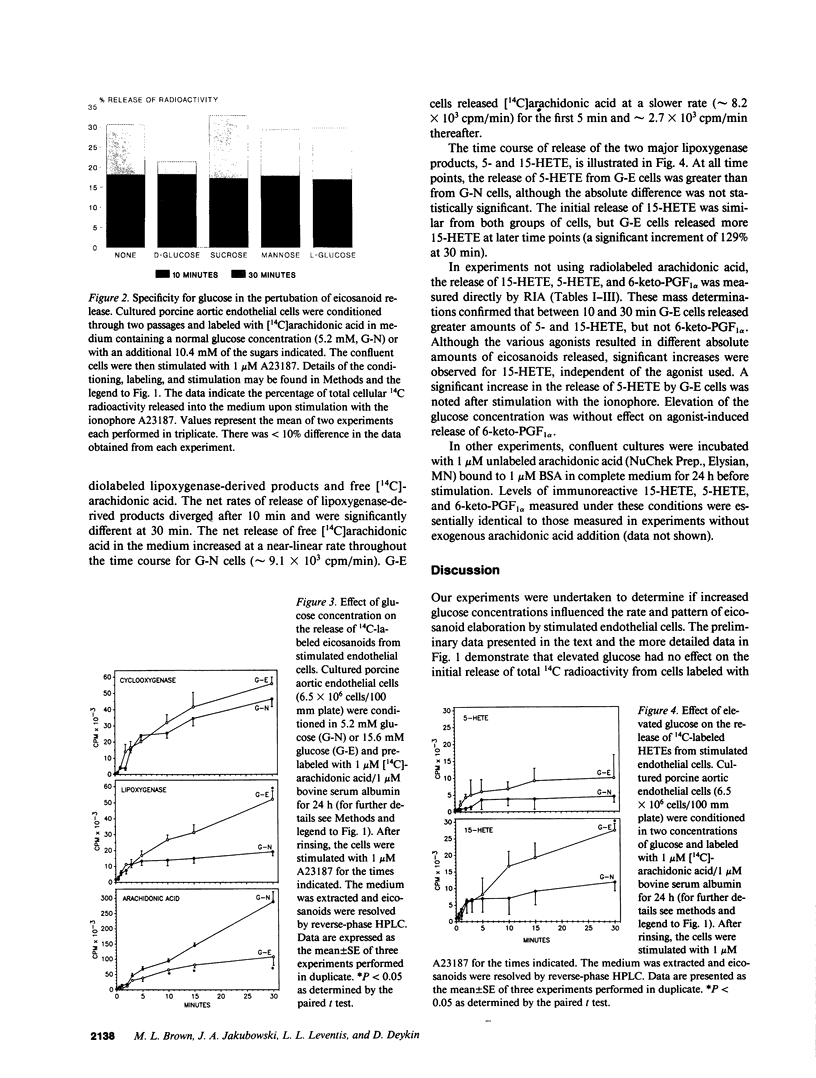
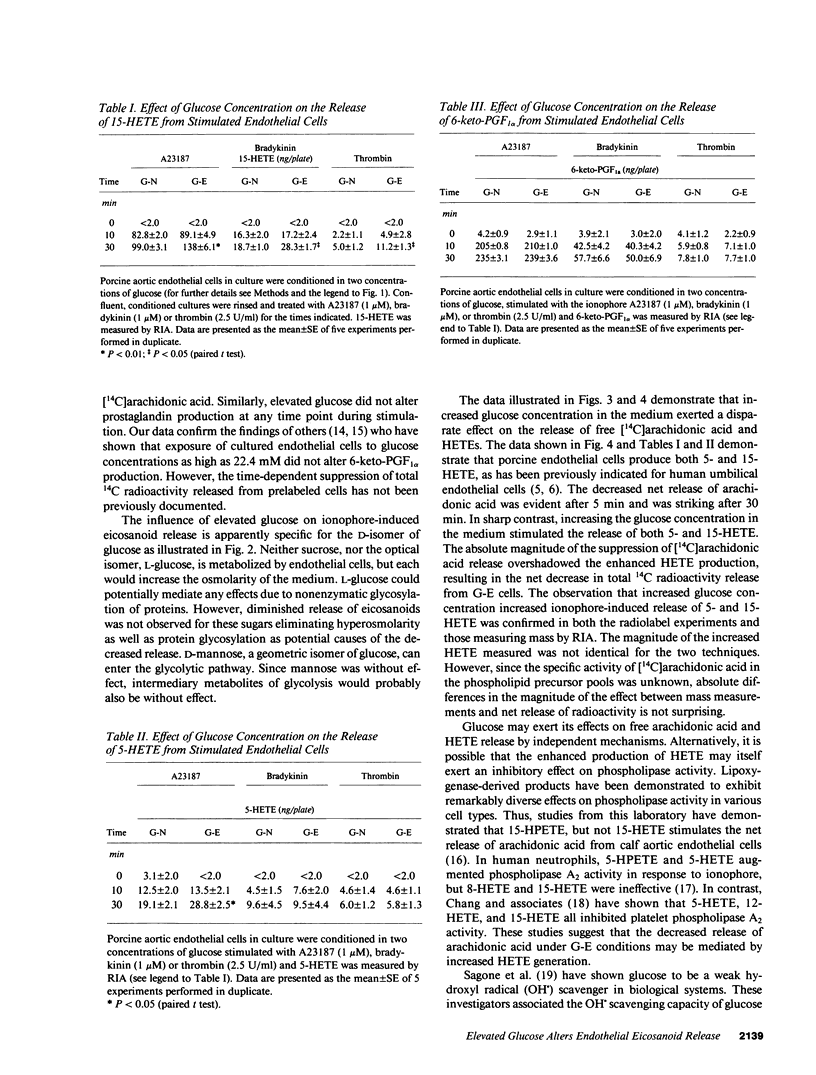
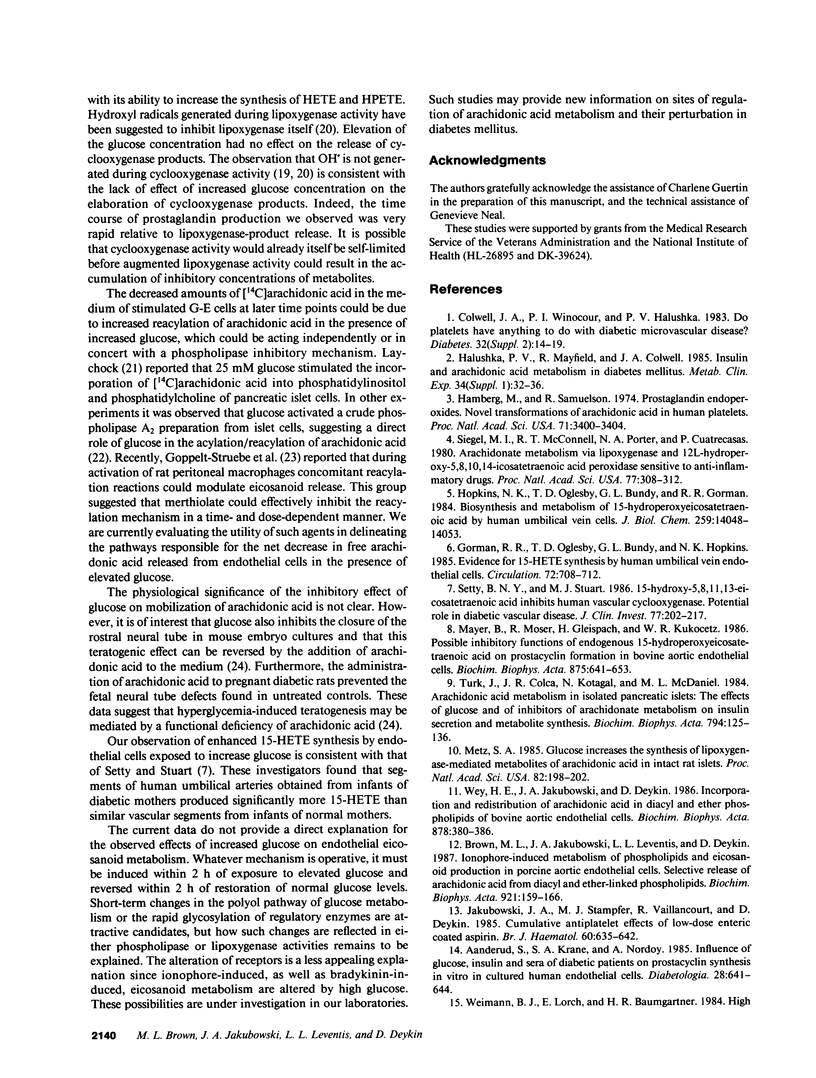
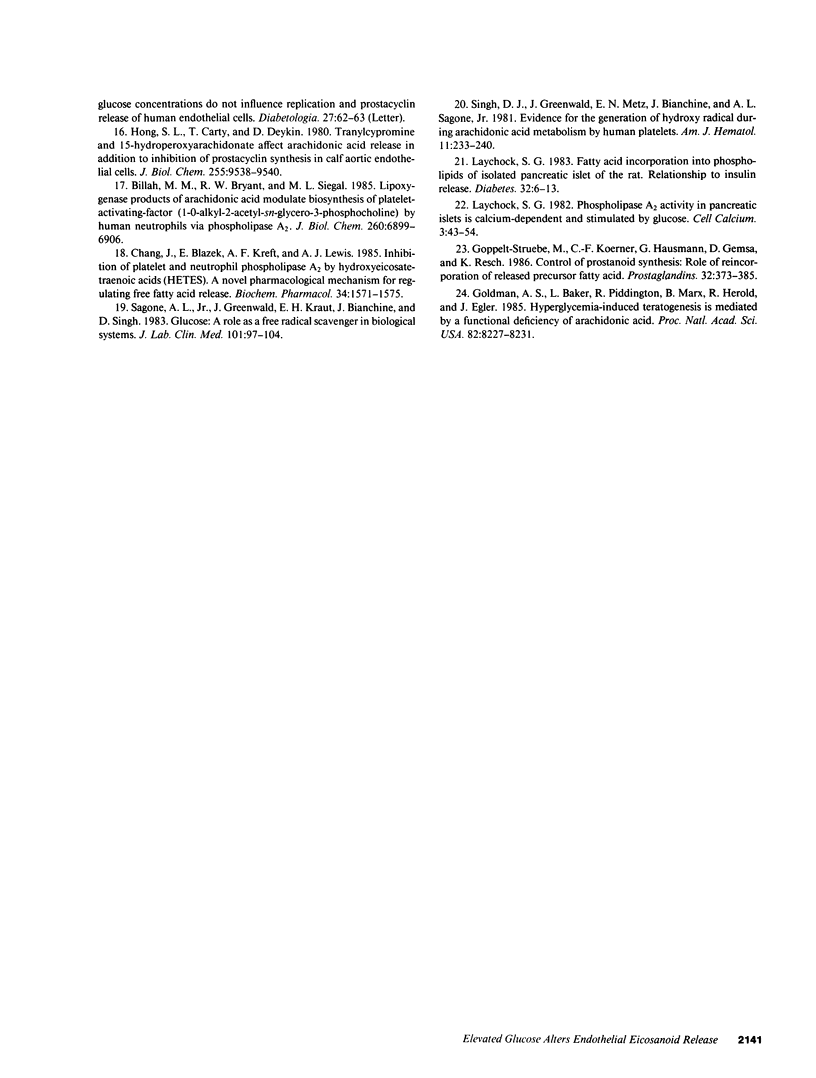
Images in this article
Selected References
These references are in PubMed. This may not be the complete list of references from this article.
- Aanderud S., Krane H., Nordøy A. Influence of glucose, insulin and sera from diabetic patients on the prostacyclin synthesis in vitro in cultured human endothelial cells. Diabetologia. 1985 Sep;28(9):641–644. doi: 10.1007/BF00291967. [DOI] [PubMed] [Google Scholar]
- Billah M. M., Bryant R. W., Siegel M. I. Lipoxygenase products of arachidonic acid modulate biosynthesis of platelet-activating factor (1-O-alkyl-2-acetyl-sn-glycero-3-phosphocholine) by human neutrophils via phospholipase A2. J Biol Chem. 1985 Jun 10;260(11):6899–6906. [PubMed] [Google Scholar]
- Brown M. L., Jakubowski J. A., Leventis L. L., Deykin D. Ionophore-induced metabolism of phospholipids and eicosanoid production in porcine aortic endothelial cells: selective release of arachidonic acid from diacyl and ether phospholipids. Biochim Biophys Acta. 1987 Sep 25;921(2):159–166. doi: 10.1016/0005-2760(87)90014-2. [DOI] [PubMed] [Google Scholar]
- Chang J., Blazek E., Kreft A. F., Lewis A. J. Inhibition of platelet and neutrophil phospholipase A2 by hydroxyeicosatetraenoic acids (HETES). A novel pharmacological mechanism for regulating free fatty acid release. Biochem Pharmacol. 1985 May 1;34(9):1571–1575. doi: 10.1016/0006-2952(85)90701-4. [DOI] [PubMed] [Google Scholar]
- Colwell J. A., Winocour P. D., Halushka P. V. Do platelets have anything to do with diabetic microvascular disease? Diabetes. 1983 May;32 (Suppl 2):14–19. doi: 10.2337/diab.32.2.s14. [DOI] [PubMed] [Google Scholar]
- Goldman A. S., Baker L., Piddington R., Marx B., Herold R., Egler J. Hyperglycemia-induced teratogenesis is mediated by a functional deficiency of arachidonic acid. Proc Natl Acad Sci U S A. 1985 Dec;82(23):8227–8231. doi: 10.1073/pnas.82.23.8227. [DOI] [PMC free article] [PubMed] [Google Scholar]
- Goppelt-Struebe M., Koerner C. F., Hausmann G., Gemsa D., Resch K. Control of prostanoid synthesis: role of reincorporation of released precursor fatty acids. Prostaglandins. 1986 Sep;32(3):373–385. doi: 10.1016/0090-6980(86)90006-7. [DOI] [PubMed] [Google Scholar]
- Gorman R. R., Oglesby T. D., Bundy G. L., Hopkins N. K. Evidence for 15-HETE synthesis by human umbilical vein endothelial cells. Circulation. 1985 Oct;72(4):708–712. doi: 10.1161/01.cir.72.4.708. [DOI] [PubMed] [Google Scholar]
- Halushka P. V., Mayfield R., Colwell J. A. Insulin and arachidonic acid metabolism in diabetes mellitus. Metabolism. 1985 Dec;34(12 Suppl 1):32–36. doi: 10.1016/s0026-0495(85)80007-x. [DOI] [PubMed] [Google Scholar]
- Hamberg M., Samuelsson B. Prostaglandin endoperoxides. Novel transformations of arachidonic acid in human platelets. Proc Natl Acad Sci U S A. 1974 Sep;71(9):3400–3404. doi: 10.1073/pnas.71.9.3400. [DOI] [PMC free article] [PubMed] [Google Scholar]
- Hong S. L., Carty T., Deykin D. Tranylcypromine and 15-hydroperoxyarachidonate affect arachidonic acid release in addition to inhibition of prostacyclin synthesis in calf aortic endothelial cells. J Biol Chem. 1980 Oct 25;255(20):9538–9540. [PubMed] [Google Scholar]
- Hopkins N. K., Oglesby T. D., Bundy G. L., Gorman R. R. Biosynthesis and metabolism of 15-hydroperoxy-5,8,11,13-eicosatetraenoic acid by human umbilical vein endothelial cells. J Biol Chem. 1984 Nov 25;259(22):14048–14053. [PubMed] [Google Scholar]
- Jakubowski J. A., Stampfer M. J., Vaillancourt R., Deykin D. Cumulative antiplatelet effect of low-dose enteric coated aspirin. Br J Haematol. 1985 Aug;60(4):635–642. doi: 10.1111/j.1365-2141.1985.tb07467.x. [DOI] [PubMed] [Google Scholar]
- Laychock S. G. Fatty acid incorporation into phospholipids of isolated pancreatic islets of the rat. Relationship to insulin release. Diabetes. 1983 Jan;32(1):6–13. doi: 10.2337/diab.32.1.6. [DOI] [PubMed] [Google Scholar]
- Laychock S. G. Phospholipase A2 activity in pancreatic islets is calcium-dependent and stimulated by glucose. Cell Calcium. 1982 Mar;3(1):43–54. doi: 10.1016/0143-4160(82)90036-7. [DOI] [PubMed] [Google Scholar]
- Mayer B., Moser R., Gleispach H., Kukovetz W. R. Possible inhibitory function of endogenous 15-hydroperoxyeicosatetraenoic acid on prostacyclin formation in bovine aortic endothelial cells. Biochim Biophys Acta. 1986 Feb 28;875(3):641–653. doi: 10.1016/0005-2760(86)90088-3. [DOI] [PubMed] [Google Scholar]
- Metz S. A. Glucose increases the synthesis of lipoxygenase-mediated metabolites of arachidonic acid in intact rat islets. Proc Natl Acad Sci U S A. 1985 Jan;82(1):198–202. doi: 10.1073/pnas.82.1.198. [DOI] [PMC free article] [PubMed] [Google Scholar]
- Sagone A. L., Jr, Greenwald J., Kraut E. H., Bianchine J., Singh D. Glucose: a role as a free radical scavenger in biological systems. J Lab Clin Med. 1983 Jan;101(1):97–104. [PubMed] [Google Scholar]
- Setty B. N., Stuart M. J. 15-Hydroxy-5,8,11,13-eicosatetraenoic acid inhibits human vascular cyclooxygenase. Potential role in diabetic vascular disease. J Clin Invest. 1986 Jan;77(1):202–211. doi: 10.1172/JCI112277. [DOI] [PMC free article] [PubMed] [Google Scholar]
- Siegel M. I., McConnell R. T., Porter N. A., Cuatrecasas P. Arachidonate metabolism via lipoxygenase and 12L-hydroperoxy-5,8,10,14-icosatetraenoic acid peroxidase sensitive to anti-inflammatory drugs. Proc Natl Acad Sci U S A. 1980 Jan;77(1):308–312. doi: 10.1073/pnas.77.1.308. [DOI] [PMC free article] [PubMed] [Google Scholar]
- Singh D., Greenwald J. E., Bianchine J., Metz E. N., Sagone A. L., Jr Evidence for the generation of hydroxyl radical during arachidonic acid metabolism by human platelets. Am J Hematol. 1981 Nov;11(3):233–240. doi: 10.1002/ajh.2830110303. [DOI] [PubMed] [Google Scholar]
- Turk J., Colca J. R., Kotagal N., McDaniel M. L. Arachidonic acid metabolism in isolated pancreatic islets. II. The effects of glucose and of inhibitors of arachidonate metabolism on insulin secretion and metabolite synthesis. Biochim Biophys Acta. 1984 Jun 6;794(1):125–136. doi: 10.1016/0005-2760(84)90305-9. [DOI] [PubMed] [Google Scholar]
- Wey H. E., Jakubowski J. A., Deykin D. Incorporation and redistribution of arachidonic acid in diacyl and ether phospholipids of bovine aortic endothelial cells. Biochim Biophys Acta. 1986 Oct 3;878(3):380–386. doi: 10.1016/0005-2760(86)90246-8. [DOI] [PubMed] [Google Scholar]



